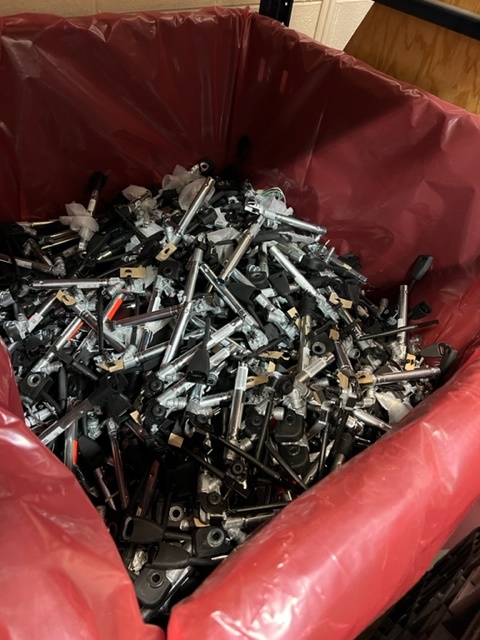Supplemental restraint systems (aka airbags) have been required in all new passenger vehicles since 1989 in the United States. Over the course of those nearly 30 years, a good many of these vehicles have seen the end of their useful lives, predictably winding up in vehicle dismantling facilities—junkyards—for recycling. Once there, undeployed airbags present safety and environmental concerns that require hazardous waste management. How so?
The Dangers of Sodium Azide
Most airbag modules include inflators that depend on sodium azide for generating the gas that “instantly” fills the bag in the event of a crash. When an airbag is deployed, sodium azide is converted into harmless nitrogen gas by other chemicals in the inflator. In fact, a fully deployed airbag can simply be handled as solid waste and disposed of in the garbage.
But sodium azide in isolation is toxic, dangerous to inhale, and can burn exposed skin. Mixed with water, it forms hydrazoic acid, which is also extremely toxic and can enter groundwater when hazardous waste removal precautions are inadequate or nonexistent.
Incidental exposure to sodium azide can occur when untrained workers dismantle vehicles in such a way as to cause the airbag suddenly to deploy. Undeployed airbag modules can also explode when exposed to the heat in an auto shredder.
A Lack of National Policy
There is no national policy about hazardous waste disposal pertaining to airbag removal from vehicles before they are recycled. In fact, the EPA allows individual states to decide whether airbags should be considered hazardous waste at all. Many states do—Oregon, Colorado, and Wisconsin among them.
For example, Oregon has required since 2005 that all airbags containing sodium azide be deployed or removed from a vehicle before it is wrecked or dismantled. But there are no prevalent state-approved practices that would point the way to a national policy.
In the meantime, vehicle dismantlers are asked to remove airbags before they sell scrapped vehicles to recycling centers. But commonly cars arrive at recycling centers with undeployed airbag modules still intact.
Removing Airbags Is Expensive
Exacerbating the problem, airbags are very difficult to access; they require specialized knowledge and skill to handle safely; and so removing them from a vehicle is costly and time-consuming. Therefore, the propensity is not to remove them, so that many if not most airbags go through the shredder, during which they get deployed from the ensuing friction and pressure, haphazardly discharging the aforementioned sodium azide into the local environment.
Airbags Are Multiplying
Where years ago just two airbags were typical in a vehicle—one in the steering wheel and another in the dashboard forward the right passenger seat—the number of airbags has increased voluminously since 1989. Nowadays, there can be side-impact airbags, curtain airbags, head-protection airbags, front center airbags, knee airbags, and more. Thereby, a late model vehicle headed for dismantling might have as many as 12 airbags requiring removal.
Recycling is a Probable Solution
Perhaps ironic in face of the hazardous waste disposal problems they can create, there is a robust market for undeployed airbags in good condition. When a vehicle is involved in an accident during which an airbag is deployed, and that vehicle is to be repaired, the deployed airbag must be replaced by federal law.
New airbags are prohibitively expensive. That creates a demand for used ones. Thus, undeployed airbags could be a saleable asset for vehicle dismantlers instead of an environmental liability requiring hazardous waste removal.
Michael E. Wilson, chief executive officer of the Automotive Recyclers Association (ARA), recently affirmed as much by saying, “Recycled OEM airbags continue to be used throughout the U.S. and around the globe. While many of the major U.S. automotive insurance companies have yet to sign onto their widespread reutilization, there continues to be a substantial market for these units. Rebuilders and consumers faced with non-insurance covered claims, among others, are currently the top users of undeployed OEM airbags.”

